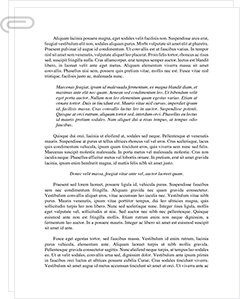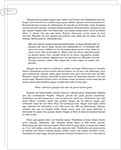 Study Document
Study Document
Consumer Choice Factors Influencing Consumer Essay
Pages:5 (1353 words)
Sources:3
Document Type:Essay
Document:#58783684
2008). Though this is not always the case, it provides a useful framework for examining how some companies use information successfully in influencing consumer choice, and how other companies are less effective in their efforts.
Coca-Cola has been one of the most successful marketers for its products that the world has ever seen. Presenting their product (with a much stronger formula) over a century ago as a beverage with medicinal qualities, the marketing and sales tactics of this company have adapted to the changing times over the past many decades with a great deal of success. An examination of some of the company's marketing techniques reveals why the company is so successful.
One of the biggest innovations consciously developed by the Coca-Cola company was the design of its contoured bottle, which set the soft drink immediately and distinctive apart from all of its competitors. This did not address the issue of the initial need for the product, which much of Coca-Cola's past and present advertising is geared towards, but rather assisted the consumer -- and the company -- in the information gathering and alternative-examining phases of the marketing process (Brown 1996). When searching for a single product amidst a plethora of highly similar choices, any piece of differentiating information can be an advantage. By making the very bottle in which the drink is delivered stand out, and then by aggressively marketing the product tying the Coca-Cola brand and quality to the easily recognized and identified shape of the bottle, Coca-Cola was providing consumers with a very definite and concrete piece of information that could be utilized in an analysis of alternatives. Other marketing techniques, such as heavy product placement tying Coca-Cola to certain celebrities and making it ubiquitous with American culture, provide more subtle and indirect information that nonetheless has a profound effect on consumer choice.
Coca-Cola's successes are sharply contrasted by the less successful efforts of other companies. Even a related and still largely successful product like Dr. Pepper can be used as an example to demonstrate an instance of weak marketing skills and techniques. Though this soft drink also sells fairly well and has also been around for quite some time, it does not sell nearly as well as Coca-Cola. Marketing can be seen as a major factor in this situation.
Dr. Pepper does engage in advertising, of course, and in some ways these efforts can be considered fairly successful -- they promote the taste and "refreshing" quality of the product being sold, providing consumers with some information about what to expect while drinking a can of Dr. Pepper. These marketing efforts do not provide a great deal of information that differentiates the product from others in the wide array of soft drinks that are available to consumers. Given the unique nature of Dr. Pepper's taste when compared to other soft drinks (even when compared to Coca-Cola's competing brand, Mr. Pibb), the failure of the company's marketing efforts in establishing this differentiation and making consumers aware of the necessary information can be seen as a major reason fro the company's reduced market share in the face of much fiercer and more effective competition. Dr. Pepper's advertising efforts promote the drink as a vaguely exciting diversion, but they do not crate a real need for the product nor do they suggest real and concrete ways in which Dr. Pepper can be seen as different from and better than other soft drinks.
Conclusion
Of all the many factors that influence consumers during the decision making process, it is the available information regarding different products and services that is most essential. Much of this information comes in the form of marketing, which companies produce in an attempt to convince consumers to choose their product or service, Many other types of information are also important, but companies have little control over these.
References
Brown, a. (1996). "Consumer behavior." Accessed 8 June 2010. http://www-rohan.sdsu.edu/~renglish/370/notes/chapt05/index.htm
Geoffs, J. (2010). "Buyer behavior." Accessed 8 June 2010. http://tutor2u.net/business/marketing/buying_decision_process.asp
Kerin, R.; Hartley, S. & Rudelius, W. (2008). Marketing. New York: McGraw-Hill.
Sample Source(s) Used
References
Brown, a. (1996). "Consumer behavior." Accessed 8 June 2010. http://www-rohan.sdsu.edu/~renglish/370/notes/chapt05/index.htm
Geoffs, J. (2010). "Buyer behavior." Accessed 8 June 2010. http://tutor2u.net/business/marketing/buying_decision_process.asp
Kerin, R.; Hartley, S. & Rudelius, W. (2008). Marketing. New York: McGraw-Hill.
Related Documents
 Study Document
Study Document
Factors Influencing Market Entry and Exit Decisions
Entering the market in a timely fashion is equally as important as exiting the market. Just as leaving the market, market entry can be planned. In any market, a business can make money by properly timing both the entry and exit. If one miscalculates any of these, then the business runs the risk of not getting the return on investment.
Entering a market
 Study Document
Study Document
Consumer Behavior During a Product Harm Crisis
Consumer Learning and Product-Harm Crisis Define a product-harm crisis A product-harm crisis refers to a situation that can trigger serious damages to a company. A crisis can threaten an organization's system and cause drastic changes in a manner that that the firm's system operates. A crisis often has a disruptive impact on organizational, social, and environmental systems. In most cases, can lead to extensive damage accompanied by significant costs imposed upon the
 Study Document
Study Document
The Consumer Decision Making Process
Consumer Decision-Making Processes The holiday season is upon us again, and it is the biggest season of the year for retailers. American consumers will buy an average of around $700 on goods and services related to the holidays, which equates to the range of $224 billion. Analysts further break down the market between those who are of relatively limited financial means and just try to survive the holidays, and those who
 Study Document
Study Document
Consumer Behavior Marketing the Role That Personality
Consumer Behavior (Marketing) The Role that Personality and Motivation Play in Consumer Behavior: A Case Study of Hongkong and Shanghai Banking Corporation (HSBC) In today's information-oriented society, research and development, particularly information research, has become an important activity for business companies, institutions, and organizations, who want to know more about the consumer market, people who consider consumption as embedded and part of their everyday lives. Initially, commercialism of goods and services through
 Study Document
Study Document
Consumer Behavior Analysis Is an Important Element
Consumer behavior analysis is an important element in relationship marketing that focuses on examining the role of the customer across various aspects. This element basically emphasizes on effective reaching out of customers and potential markets. Consumer behavior analysis is regarded as a data-centered marketing technique that is used to directly reach out to individuals with customer data assessment that help in improving an organization's business profits. Consequently, one of the
 Study Document
Study Document
Consumer Behavior and Purchase Decisions: In Today's
Consumer Behavior and Purchase Decisions: In today's society shoes are regarded as footwear products that are geared towards protecting the human foot while providing comfort to carry out several activities. In addition, they are seen as fashionable items that are used to improve self-image through providing decoration. Generally, consumer behavior and purchase decisions for these items are usually affected by various factors such as material selection, attractiveness of the store, shoe



